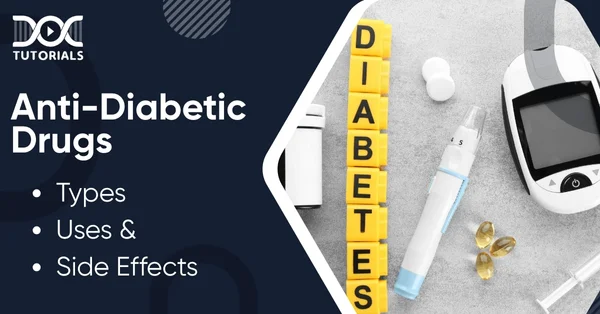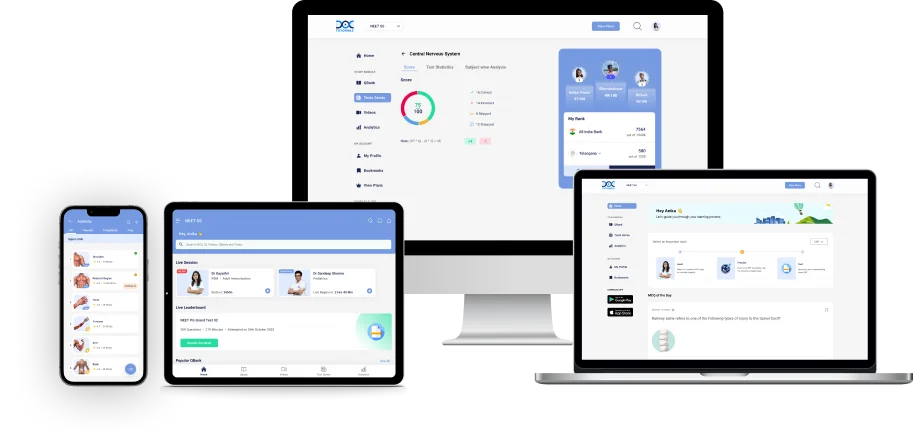Diabetic Ketoacidosis | Causes, Symptoms & Management

DKA, or diabetic ketoacidosis, is a complicated health condition that occurs in individuals with type-1 diabetes. Being a life-threatening condition, it is essential to identify its symptoms so that you can call for immediate help and avoid complications. Moreover, learning in-depth about this topic is crucial for NEET PG aspirants, not only for their syllabus but also for accurate diagnoses in clinical settings.
Keep reading to learn about the causes, symptoms, diagnosis, and treatment methods for diabetic ketoacidosis.
What is Diabetic Ketoacidosis?
Diabetic ketoacidosis occurs in a diabetic or undiagnosed diabetic patient when their body lacks the required amount of insulin. Such a condition requires urgent medical intervention, as it can make the affected person’s blood acidic and cause dehydration.
In the human body, insulin helps burn glucose and release energy. If the body lacks sufficient insulin, the liver starts to break down body fat to release energy. While doing this, the liver also releases ketones into one’s bloodstream while breaking down fats. Excessive ketones can reduce the pH level of one’s blood, making it acidic.
What are the Causes and Risk Factors of Diabetic Ketoacidosis?
Here are some of the factors that can cause or increase the risk of diabetes ketoacidosis:
- Infections
If an individual is affected by UTI (urinary tract infection) or pneumonia, their body will demand more insulin, leading to DKA (Diabetic Ketoacidosis).
- Mismanaged Diabetes
If a diabetic patient does not take the required insulin or misses the doses, the glucose regulation will be disrupted. It will lead to an increase in ketone production, increasing the risk of diabetic ketoacidosis.
- Stroke or Heart Attack
Individuals who have had a heart attack or stroke can experience insulin resistance, leading to diabetes ketoacidosis.
- Use of Alcohol or Drugs
The risk of DKA can be raised by excessive alcohol use or by taking certain medications, like corticosteroids.
- Trauma and Stress
When an individual suffers from physical or emotional trauma or stress, it elevates the hormone levels. This can reduce the insulin level, increasing the risk of diabetic ketoacidosis.
- Pregnancy
Diabetes increases the risk of diabetic ketoacidosis (DKA) in pregnant women because pregnancy alters how the body uses carbohydrates and other nutrients.
- Sickness
When you’re ill or under stress, your body produces more stress chemicals, such as cortisol and adrenaline. These hormones can interfere with insulin’s ability to assist sugar in entering your cells.
What are the Symptoms of Diabetic Ketoacidosis?
The symptoms of diabetic ketoacidosis appear quickly and can be the early signs of diabetes for the affected individual. Here are some of the common signs to look out for:
- Dehydration
- Extreme thirst
- Frequent urge to urinate
- Strong headache
- High amount of ketones in blood
- Above 250 mg/dL blood sugar levels
The affected person can get more symptoms like the following if they don’t get medical assistance:
- Vomiting and nausea
- Dry skin and mouth
- Muscle stiffness, aches, and weakness
- Fatigue
- Stomach pain
- Feeling of confusion, less attentiveness
- Headache
- Fruity- or sweet-smelling breath
- Red, sweaty, or hot face
- Fast breathing
- Shortness of breath
If you notice any of the following signs, call for emergency help right away to avoid life-threatening risks:
- Vomiting for 2 hours or more
- A high blood sugar level above 300 that does not go down
- High or moderate ketones with any of the DKA symptoms
- Foggy or woozy feeling, etc.
How to Diagnose Diabetic Ketoacidosis?
Here are some of the diagnostic tests that help detect diabetic ketoacidosis:
- Blood Tests
Doctors ask for blood tests while diagnosing diabetic ketoacidosis to measure the following:
- Blood Sugar Level
The blood sugar level of an individual rises if the body lacks a sufficient insulin level that allows glucose to enter the cells. This condition is called hyperglycemia. The blood sugar level keeps rising as the individual’s body breaks down protein and fat to release energy.
- Blood Acidity
An individual’s blood becomes acidic when the ketone level in their blood becomes too high. It can affect the functioning of organs throughout the human body.
- Ketone Level
The body releases chemicals called ketones into the blood when it breaks down protein and fat for energy.
- Other Tests
In addition to these blood tests, other investigations may be needed to find the underlying cause of DKA or to identify complications. These include the following:
- Chest X-ray
- Urinalysis
- Blood electrolyte tests
- Electrocardiogram
What are the Treatment Options of Diabetic Ketoacidosis?
If you are diagnosed with diabetic ketoacidosis (DKA), you will likely be treated in the emergency room or admitted to the hospital for close monitoring. The primary treatment steps include the following:
- Fluid replacement
- Electrolyte correction
- Insulin therapy
Fluids are given, often through an IV, to replace the water lost from excessive urination and to dilute high blood sugar levels. Electrolyte replacement is also necessary, as DKA can cause low levels of essential minerals like sodium, potassium, and chloride; these are given intravenously to help keep the heart, muscles, and nerves functioning properly.
Insulin is administered through an IV to lower blood sugar levels and stop the body from producing more ketones, which cause acidity in the blood. Once blood sugar drops to around 200 mg/dL and blood acidity improves, patients can often return to their usual insulin routine. Careful monitoring continues until full recovery.
FAQs About Diabetic Ketoacidosis
- How to prevent diabetic ketoacidosis?
To prevent diabetic ketoacidosis, regularly monitor your blood sugar, take insulin or medication as prescribed, check for ketones during high readings, maintain your insulin pump, follow a sick-day plan, and see your doctor regularly.
- How long can a DKA-affected individual survive?
DKA survival rates are at present over 95% with proper treatment. However, delayed care, advanced age with other illnesses, and brain swelling, especially in youth, can increase the risk of death.
- What are the complications of diabetic ketoacidosis?
Without emergency treatment for DKA, complications can include dangerously low blood sugar, low potassium, brain swelling if blood sugar drops too fast, loss of consciousness, and even death.
Conclusion
Diabetic ketoacidosis (DKA) is a serious complication found in individuals with type-1 diabetes. Knowing its warning signs and triggers is crucial for responding quickly and preventing complications. Besides, if you are an NEET PG aspirant, you must get a detailed understanding of this topic for your exam as well as your future career as a medical professional.
DocTutorials can help you with that. Our top-grade study materials, detailed video lectures, routine assessments, one-to-one learning process, and other resources help every aspirant prepare for their exams efficiently. Join our NEET PG course for professional guidance!
Latest Blogs
-

NEET SS Exam 2024: Analysis, Key Dates, Counselling
The NEET SS 2024 exam kicked off on March 29, 2025. Over two days and two slots, candidates across 13…
-

NEET PG Registration 2025: An Essential Guide For Exam Prep
The NEET PG registration, which is conducted online, is a crucial step in the exam process. Filling out the NEET…
-

NEET PG Syllabus 2025: A Must-Have Complete Guide for Exam Success
The NEET PG Syllabus acts as one of the foundation stones for aspiring postgraduate medical students like you who are…




